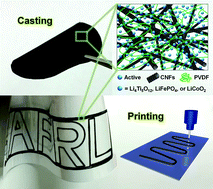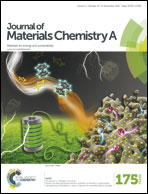Composite batteries: a simple yet universal approach to 3D printable lithium-ion battery electrodes†
Abstract
Printable energy storage is anticipated to facilitate innovation in the manufacture of flexible electronics and soft robotics by enabling direct integration of a power source into a system during the fabrication process. To this end, we have established a universal approach to develop 3D printable, free-standing electrodes with an embedded current collector for high-performance Li-ion batteries. This simple approach utilizes a well-dispersed mixture of active material, carbon nanofibers, and polymer to make castable or printable electrode inks. By tuning the ratios of these components in a series of inks, we have observed the effect each parameter had on the resulting rheological, electrochemical, and mechanical properties. Once properly balanced, free-standing electrodes of three common Li-ion battery active materials (i.e., lithium titanate (Li4Ti5O12), lithium iron phosphate (LiFePO4), and lithium cobalt oxide (LiCoO2)) were prepared, each demonstrating excellent cyclability and rate capability. Finally, electrodes were successfully patterned using a direct ink writing method, and a fully-printed, working electrode plus separator electrode assembly were developed.


 Please wait while we load your content...
Please wait while we load your content...